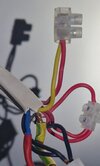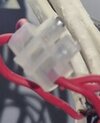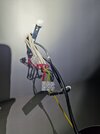You are using an out of date browser. It may not display this or other websites correctly.
You should upgrade or use an alternative browser.
You should upgrade or use an alternative browser.
Changing light pendant to one that only has live, earth and neutral
- Thread starter Harry_W
- Start date
- Joined
- 8 May 2017
- Messages
- 10,544
- Reaction score
- 2,812
- Country

Is your testing instrument a non contact voltage tester ?
If it is...in your top picture above ,there is a terminal block that has a black with red sleeve ( next to earth conductors ,and 3 black in the other terminal).
Is that black with red sleeve lighting up your volt pen when switches are in ON position ?
By the way ,the 3 blacks don't look as though they are fully inserted in the terminal,their copper conductors must all be clamped by the terminal screw,check that they are.
If it is...in your top picture above ,there is a terminal block that has a black with red sleeve ( next to earth conductors ,and 3 black in the other terminal).
Is that black with red sleeve lighting up your volt pen when switches are in ON position ?
By the way ,the 3 blacks don't look as though they are fully inserted in the terminal,their copper conductors must all be clamped by the terminal screw,check that they are.
I've pushed the neutrals in further and checked that both switch lives have power with my detector. One light works and the other does not. The living room and dining room lights are not working either.
- Joined
- 8 May 2017
- Messages
- 10,544
- Reaction score
- 2,812
- Country

Is it the light that the terminal block, Quoted in my earlier post, is connected to that works ok ? Switches on and off ok as well ?
- Joined
- 7 Sep 2022
- Messages
- 4,486
- Reaction score
- 1,287
- Country

That's a clue that the lights downstream of this fitting have become disconnected, i.e your "loop in-loop out" no longer does soThe living room and dining room lights are not working either.
If lights upstream still work then you can identify which is your loop in wire by testing which red is currently live
Yes the light with the neutrals that weren't fully pushed in is now working and the light switch works to turn it on and off
- Joined
- 8 May 2017
- Messages
- 10,544
- Reaction score
- 2,812
- Country

Are any of the wires in your second pic showing as live ? You may need to seperate them out into individual terminal blocks to determine. And a twin probe voltage tester or multimeter would be more useful than the volt stick you have.
The black wires in that terminal block also don't look too well fitted.
The black wires in that terminal block also don't look too well fitted.
Thank you for your clear explanation @RandomGrinch. Could I use a connector block for the lives and just screw two in each side?
I'm sorry, I had missed this -And this light, is there perhaps another one that comes on at the same time..
ie on the same switch?
I read that as '2 lights turned on by one switch'? Which may suggest that all 4 reds wouldn't be connected in the loop.changing a light pendant, one of two in the hallway controlled by a 3 way light switch,
On the second pendant, there is an RYB cable with a link to a red. If these cables are connected to the other pendant, then this switched live would now be a permanent live with all 4 reds in the loop.

I may be being silly, but wouldn't that just mean a lamp stays on, rather than causing these problems?
I wonder what happens if that yellow was temporarily disconnected?
...but also, this screw needs tightening.

Good spot at Christmas mr Grinch!
The second light means that more investigation is needed, perhaps to identify the cable for that light and leave it out.
Just get one light working first. There’s a way to do this but I got a busy week so can’t spend time doing a remote basic electricians course. Hope you/someone else can get it sorted for the OP.
The second light means that more investigation is needed, perhaps to identify the cable for that light and leave it out.
Just get one light working first. There’s a way to do this but I got a busy week so can’t spend time doing a remote basic electricians course. Hope you/someone else can get it sorted for the OP.
I've now checked all wires are correctly installed. The light nearest to the front door is working but no other lights after it are working downstairs. I've disconnected the yellow wire and there was no change. I've worked out the working light is controlled separately by two switches, the last of the three in the photo and one by the switch that does the outside front door light. I've hit a dead end.
- Joined
- 7 Sep 2022
- Messages
- 4,486
- Reaction score
- 1,287
- Country

Then we need to start pulling it apart in other places
Your light switch shows 3 switches. If only one of them is being used for the problem lights and the other two serve lights that have not been disturbed, then leave them alone and don't consider them. Pull the switch off and label up the wire that goes to the particular switch that used to operate this light (you should be able to see which switch goes to which wire just by physical correlation) with an A, 1 or something. If there are multiple wires to the switch, use different letters
If there is another switch elsewhere that also controlled the problem lights, pull that switch off and find the relevant wire and label it again with totally different letters (once you work out which wires go to where you can either relabel them or write a map of a<->b etc)
Once you've got your switch wires labelled up, clip a 9V (or 1.5v, or whatever) battery onto one pair of wires from them (handy if you get some crocodile clips on a wire) and go round with your multimeter (buy a cheap one) finding the other end of the wire that shows 9V. Remember that most meters have a different switch setting for AC vs DC (DC is a solid line and dotted line, AC is a wiggly line). Remember that at least one wire in the ceiling you've shown us will go to the other light fitting (you said there were 2 luminaires, right?), one wire will come from the last light or fuse box, one wire goes to the next light. The 9v battery means you can detect voltages when the mains it turned off - turn the mains off when doing this. About the only time you might want to use 240v for diagnostic is when working out which wire comes from the fusebox, and you can't be bothered disconnecting the fuse box end in order to clip the 9v battery in) but remember that gripping a hold of a wire with 240v on could kill you, so do work safely.
You need to get to a situation where you know, for all those wires in the ceiling, where they go and how many cores in them. Once you have that you can draw us a sketch of what it looks like, all labelled up with your letters, and we can tell you "at the light, put the BLACKS from wires D F and G into one junction block, along with the neutral of the new light fitting you want to install.. put the reds from D A and F into a junction block, put the black from B into the live of the new light fitting.." and we can just do this as electrics by numbers
Handy for your 9v battery, should be a couple of quid:

£8 for a multimeter, will come in handy for all sorts even stuff like checking fuses are blown or AA batteries are dead: https://www.screwfix.com/p/lap-ac-dc-digital-multimeter-600v/75337
Which mode to use depends on whether you're checking for 9v DC battery or 240v AC power. Use the range that is higher than your max (put it on 600v AC for testing UK power)

Do not use A (amps) testing mode; you'll blow the fuse in the meter for sure. Only use V (volts) testing mode
Your light switch shows 3 switches. If only one of them is being used for the problem lights and the other two serve lights that have not been disturbed, then leave them alone and don't consider them. Pull the switch off and label up the wire that goes to the particular switch that used to operate this light (you should be able to see which switch goes to which wire just by physical correlation) with an A, 1 or something. If there are multiple wires to the switch, use different letters
If there is another switch elsewhere that also controlled the problem lights, pull that switch off and find the relevant wire and label it again with totally different letters (once you work out which wires go to where you can either relabel them or write a map of a<->b etc)
Once you've got your switch wires labelled up, clip a 9V (or 1.5v, or whatever) battery onto one pair of wires from them (handy if you get some crocodile clips on a wire) and go round with your multimeter (buy a cheap one) finding the other end of the wire that shows 9V. Remember that most meters have a different switch setting for AC vs DC (DC is a solid line and dotted line, AC is a wiggly line). Remember that at least one wire in the ceiling you've shown us will go to the other light fitting (you said there were 2 luminaires, right?), one wire will come from the last light or fuse box, one wire goes to the next light. The 9v battery means you can detect voltages when the mains it turned off - turn the mains off when doing this. About the only time you might want to use 240v for diagnostic is when working out which wire comes from the fusebox, and you can't be bothered disconnecting the fuse box end in order to clip the 9v battery in) but remember that gripping a hold of a wire with 240v on could kill you, so do work safely.
You need to get to a situation where you know, for all those wires in the ceiling, where they go and how many cores in them. Once you have that you can draw us a sketch of what it looks like, all labelled up with your letters, and we can tell you "at the light, put the BLACKS from wires D F and G into one junction block, along with the neutral of the new light fitting you want to install.. put the reds from D A and F into a junction block, put the black from B into the live of the new light fitting.." and we can just do this as electrics by numbers
Handy for your 9v battery, should be a couple of quid:
£8 for a multimeter, will come in handy for all sorts even stuff like checking fuses are blown or AA batteries are dead: https://www.screwfix.com/p/lap-ac-dc-digital-multimeter-600v/75337
Which mode to use depends on whether you're checking for 9v DC battery or 240v AC power. Use the range that is higher than your max (put it on 600v AC for testing UK power)
Do not use A (amps) testing mode; you'll blow the fuse in the meter for sure. Only use V (volts) testing mode
Last edited:
DIYnot Local
Staff member
If you need to find a tradesperson to get your job done, please try our local search below, or if you are doing it yourself you can find suppliers local to you.
Select the supplier or trade you require, enter your location to begin your search.
Please select a service and enter a location to continue...
Are you a trade or supplier? You can create your listing free at DIYnot Local
Similar threads
- Replies
- 4
- Views
- 3K
- Replies
- 4
- Views
- 3K
- Replies
- 5
- Views
- 11K


